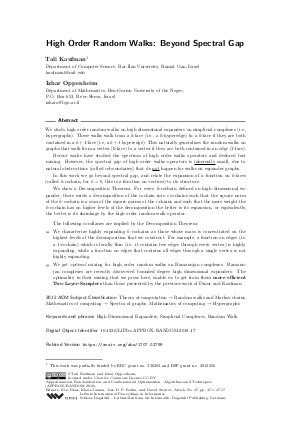High Order Random Walks: Beyond Spectral Gap
Authors Tali Kaufman, Izhar Oppenheim
-
Part of:
Volume:
Approximation, Randomization, and Combinatorial Optimization. Algorithms and Techniques (APPROX/RANDOM 2018)
Part of: Series: Leibniz International Proceedings in Informatics (LIPIcs)
Part of: Conference: International Conference on Randomization and Computation (RANDOM)
Part of: Conference: International Conference on Approximation Algorithms for Combinatorial Optimization Problems (APPROX) - License:
 Creative Commons Attribution 3.0 Unported license
Creative Commons Attribution 3.0 Unported license
- Publication Date: 2018-08-13
File

PDF
LIPIcs.APPROX-RANDOM.2018.47.pdf
- Filesize: 453 kB
- 17 pages
Document Identifiers
Related Versions
Subject Classification
ACM Subject Classification
- Theory of computation → Random walks and Markov chains
- Mathematics of computing → Spectra of graphs
- Mathematics of computing → Hypergraphs
Keywords
- High Dimensional Expanders
- Simplicial Complexes
- Random Walk
Metrics
- Access Statistics
-
Total Accesses (updated on a weekly basis)
0Document
0Metadata
Abstract
We study high order random walks on high dimensional expanders on simplicial complexes (i.e., hypergraphs). These walks walk from a k-face (i.e., a k-hyperedge) to a k-face if they are both contained in a k+1-face (i.e, a k+1 hyperedge). This naturally generalizes the random walks on graphs that walk from a vertex (0-face) to a vertex if they are both contained in an edge (1-face). Recent works have studied the spectrum of high order walks operators and deduced fast mixing. However, the spectral gap of high order walks operators is inherently small, due to natural obstructions (called coboundaries) that do not happen for walks on expander graphs. In this work we go beyond spectral gap, and relate the expansion of a function on k-faces (called k-cochain, for k=0, this is a function on vertices) to its structure. We show a Decomposition Theorem: For every k-cochain defined on high dimensional expander, there exists a decomposition of the cochain into i-cochains such that the square norm of the k-cochain is a sum of the square norms of the i-chains and such that the more weight the k-cochain has on higher levels of the decomposition the better is its expansion, or equivalently, the better is its shrinkage by the high order random walk operator. The following corollaries are implied by the Decomposition Theorem: - We characterize highly expanding k-cochains as those whose mass is concentrated on the highest levels of the decomposition that we construct. For example, a function on edges (i.e. a 1-cochain) which is locally thin (i.e. it contains few edges through every vertex) is highly expanding, while a function on edges that contains all edges through a single vertex is not highly expanding. - We get optimal mixing for high order random walks on Ramanujan complexes. Ramanujan complexes are recently discovered bounded degree high dimensional expanders. The optimality in their mixing that we prove here, enable us to get from them more efficient Two-Layer-Samplers than those presented by the previous work of Dinur and Kaufman.
Cite As Get BibTex
Tali Kaufman and Izhar Oppenheim. High Order Random Walks: Beyond Spectral Gap. In Approximation, Randomization, and Combinatorial Optimization. Algorithms and Techniques (APPROX/RANDOM 2018). Leibniz International Proceedings in Informatics (LIPIcs), Volume 116, pp. 47:1-47:17, Schloss Dagstuhl – Leibniz-Zentrum für Informatik (2018)
https://doi.org/10.4230/LIPIcs.APPROX-RANDOM.2018.47
BibTex
@InProceedings{kaufman_et_al:LIPIcs.APPROX-RANDOM.2018.47,
author = {Kaufman, Tali and Oppenheim, Izhar},
title = {{High Order Random Walks: Beyond Spectral Gap}},
booktitle = {Approximation, Randomization, and Combinatorial Optimization. Algorithms and Techniques (APPROX/RANDOM 2018)},
pages = {47:1--47:17},
series = {Leibniz International Proceedings in Informatics (LIPIcs)},
ISBN = {978-3-95977-085-9},
ISSN = {1868-8969},
year = {2018},
volume = {116},
editor = {Blais, Eric and Jansen, Klaus and D. P. Rolim, Jos\'{e} and Steurer, David},
publisher = {Schloss Dagstuhl -- Leibniz-Zentrum f{\"u}r Informatik},
address = {Dagstuhl, Germany},
URL = {https://drops.dagstuhl.de/entities/document/10.4230/LIPIcs.APPROX-RANDOM.2018.47},
URN = {urn:nbn:de:0030-drops-94516},
doi = {10.4230/LIPIcs.APPROX-RANDOM.2018.47},
annote = {Keywords: High Dimensional Expanders, Simplicial Complexes, Random Walk}
}
Author Details
Funding
- Kaufman, Tali: This work was partially funded by ERC grant no. 336283 and BSF grant no. 2012256
References
- W. Ballmann and J. Świątkowski. On L²-cohomology and property (T) for automorphism groups of polyhedral cell complexes. Geom. Funct. Anal., 7(4):615-645, 1997. URL: http://dx.doi.org/10.1007/s000390050022.
-
Boaz Barak, Parikshit Gopalan, Johan Håstad, Raghu Meka, Prasad Raghavendra, and David Steurer. Making the long code shorter. SIAM J. Comput., 44(5):1287-1324, 2015.

-
Irit Dinur and Tali Kaufman. High dimensional expanders imply agreement expanders. Electronic Colloquium on Computational Complexity (ECCC), 2017.

- Irit Dinur, Subhash Khot, Guy Kindler, Dor Minzer, and Muli Safra. Towards a proof of the 2-to-1 games conjecture? Electronic Colloquium on Computational Complexity (ECCC), 23:198, 2016. URL: http://eccc.hpi-web.de/report/2016/198.
- Irit Dinur, Subhash Khot, Guy Kindler, Dor Minzer, and Muli Safra. On non-optimally expanding sets in grassmann graphs. Electronic Colloquium on Computational Complexity (ECCC), 24:94, 2017. URL: https://eccc.weizmann.ac.il/report/2017/094.
-
Howard Garland. p-adic curvature and the cohomology of discrete subgroups of p-adic groups. Ann. of Math. (2), 97:375-423, 1973.

- Anna Gundert and Uli Wagner. On Laplacians of random complexes. In Computational geometry (SCG'12), pages 151-160. ACM, New York, 2012. URL: http://dx.doi.org/10.1145/2261250.2261272.
-
Tali Kaufman and David Mass. High dimensional combinatorial random walks and colorful expansion. In ITCS, 2017.

- Alexander Lubotzky, Beth Samuels, and Uzi Vishne. Explicit constructions of ramanujan complexes of type. Eur. J. Comb., 26(6):965-993, 2005. URL: http://dx.doi.org/10.1016/j.ejc.2004.06.007.
- Izhar Oppenheim. Vanishing of cohomology and property (T) for groups acting on weighted simplicial complexes. Groups Geom. Dyn., 9(1):67-101, 2015. URL: http://dx.doi.org/10.4171/GGD/306.
- Izhar Oppenheim. Local spectral expansion approach to high dimensional expanders Part I: Descent of spectral gaps. Discrete Comput. Geom., 59(2):293-330, 2018. URL: http://dx.doi.org/10.1007/s00454-017-9948-x.
